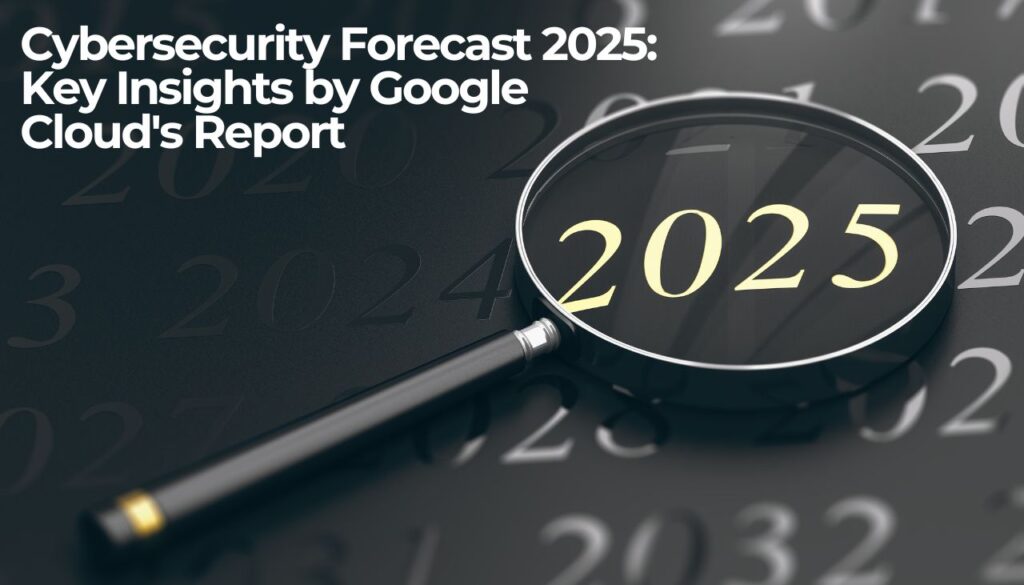Prediction reports about the state of cybersecurity in 2025 are already looming. Our attention was drawn by one particular report – Google Cloud Security’s Cybersecurity Forecast 2025.
What does the technology giant foresee for 2025?
What sets this cybersecurity forecast apart from other industry predictions is its focus on recent patterns and developments in the cybersecurity sector rather than speculations and assumptions.

What Does “Google Cloud Security’s Cybersecurity Forecast 2025” Say?
Google Cloud’s comprehensive report draws on insights from over a dozen security leaders and researchers, and highlights critical priorities for defenders in the field. Key topics include the emergence of adversarial AI as a tool for sophisticated attacks, the geopolitical threats posed by nation-states like Russia, China, North Korea, and Iran, and the rapid evolution of ransomware tactics designed to bypass traditional defenses.
Technology advances, threats evolve, the cybersecurity landscape changes, and defenders must adapt to it all if they want to keep up. The Google Cloud Cybersecurity Forecast 2025 report aims to help the cybersecurity industry frame its fight against cyber adversaries in 2025.
The report also delves into vulnerabilities within cloud infrastructures and the incipient Web3 ecosystem, both of which present unique security challenges as adoption grows. In addition, the rise of infostealer malware sets an alarming trend in data exfiltration, targeting both individuals and organizations.
Here’s a breakdown of the key insights in the report across various cybersecurity sectors.
Exploitation of Artificial Intelligence by Cybercriminals
Attackers are increasingly using AI to heighten both the complexity and scale of cyberattacks. From employing large language models (LLMs) to automate phishing schemes to using deepfake technology for identity fraud, the integration of AI into malicious operations is a growing concern. Businesses must anticipate adversaries leveraging AI to streamline reconnaissance and develop exploits more efficiently.
AI in Disinformation Campaigns
Artificial intelligence is predicted to amplify the scope of information operations by enabling more convincing and scalable content creation. These tools allow attackers to craft persuasive disinformation and develop more authentic-seeming fake identities, significantly undermining information credibility.
Cyber Activities by Geopolitical Actors
Key nations — Russia, China, Iran, and North Korea — will continue leveraging cyber capabilities for espionage, criminal activities, and influence operations aligned with their geopolitical agendas. For example, Russia’s cyber focus will likely revolve around the ongoing Ukraine conflict, while China is expected to deploy subtle and persistent espionage techniques.
Rise of Ransomware with Layered Extortion Tactics
Ransomware remains a critical threat, with attackers evolving their strategies to include multifaceted extortion. Beyond encrypting data, perpetrators now frequently threaten to leak sensitive information, intensifying pressure on victims to comply with their demands.
Surge in Infostealer Malware
Infostealer malware is on the rise, targeting personal and corporate data such as login credentials. These malicious tools significantly raise the risks of data breaches and unauthorized account access, making them a growing concern for organizations.
Widespread Access to Advanced Cyber Tools
The increasing availability of advanced cyber tools has lowered the barrier for less-skilled actors to participate in cybercrime. This democratization fuels a broader and more diverse range of threats, amplifying the volume of attacks across industries.
Challenges of Compromised Identities in Hybrid Systems
Hybrid environments are especially vulnerable to identity compromises. Attackers leveraging stolen credentials can infiltrate systems, underscoring the importance of stringent identity and access management practices.
Threats to Web3 and Cryptocurrency Assets
Companies in the Web3 and cryptocurrency sectors are becoming prime targets for digital asset theft. Cybercriminals exploit weaknesses in smart contracts and deploy advanced phishing schemes, exposing this emerging sector to significant risks.
Accelerated Exploitation of Vulnerabilities
The time between vulnerability discovery and exploitation is shrinking. At the same time, a wider array of vendors is being targeted. These trends stress the need for swift patch management and proactive vulnerability mitigation strategies.
Conclusion on the Cybersecurity Forecast 2025
In 2025, as per the report, rapid advancements in AI will benefit both defenders and attackers, enabling sophisticated social engineering and disinformation campaigns. Major threats include cyber activities from Russia, China, Iran, and North Korea, as well as rising ransomware, extortion, and infostealer malware.
Organizations must adopt proactive cybersecurity strategies, including:
- Cloud-native security solutions.
- Strong identity and access management.
- Continuous monitoring and threat intelligence.
- Preparation for post-quantum cryptography.
- Compliance with evolving regulations.
The idea of Google Cloud’s Cybersecurity Forecast 2025 is to equip organizations with the necessary information to strengthen defenses and build resilience against evolving threats.


